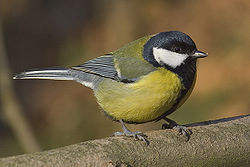| Parus | |
|---|---|
 | |
| Great tit Parus major | |
| Scientific classification | |
| Domain: | Eukaryota |
| Kingdom: | Animalia |
| Phylum: | Chordata |
| Class: | Aves |
| Order: | Passeriformes |
| Family: | Paridae |
| Genus: | Parus Linnaeus, 1758 |
| Type species | |
| Parus major (great tit) Linnaeus, 1758 | |
| Species | |
See text | |
 | |
| Distribution of the species in the genus Parus. Parus bokharensis is now treated as a subspecies of P. major | |
Parus is a genus of Old World birds in the tit family Paridae. It was formerly a large genus containing most of the 50 odd species in the family Paridae. The genus was split into several resurrected genera following the publication of a detailed molecular phylogenetic analysis in 2013. [1] [2] The genus name, Parus, is the Latin word for "tit".





